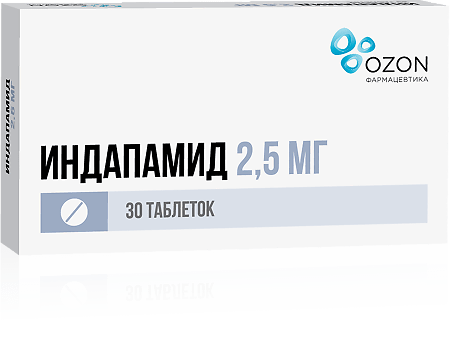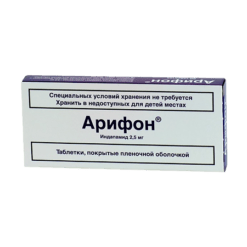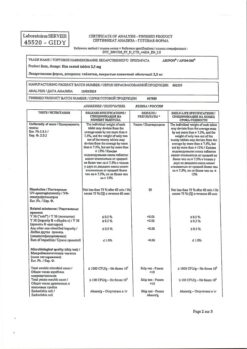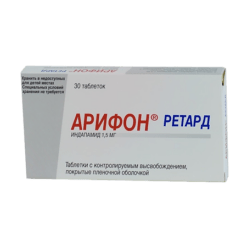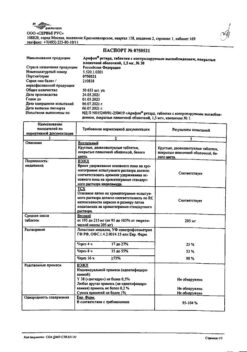No products in the cart.
Indapamide, 2.5mg 30 pcs
€3.16 €2.87
Description
Indapamide is a thiazide-like diuretic, an antihypertensive agent. It causes reduction of arterial smooth muscle tone, decreases PPS, also has moderate saluretic activity due to impaired reabsorption of sodium, chlorine and water ions in the cortical segment of the Genle loop and proximal convoluted tubule of nephron. Reduction of RPS is due to several mechanisms: decreased sensitivity of the vascular wall to noradrenaline and angiotensin II; increased synthesis of prostaglandins with vasodilatory activity; inhibition of calcium ions influx into the smooth muscle elements of the vascular wall. In therapeutic doses has almost no effect on lipid and carbohydrate metabolism.
Hypotensive effect appears only at initially elevated BP, develops by the end of the first week and reaches a maximum after 3 months of systematic use.
After oral administration, it is quickly and completely absorbed from the gastrointestinal tract, Cmax in plasma is reached after 1-2 hours. Binding to plasma proteins is 79%. Widely distributed in the body. It does not cumulate.
T1/2 is 18 hours. It is excreted by the kidneys mainly as metabolites, 5% – unchanged.
Indications
Indications
Arterial hypertension; sodium and water retention in chronic heart failure.
Active ingredient
Active ingredient
Composition
Composition
Active ingredient: indapamide 2.5 mg;
Auxiliary substances: pregelatinized starch; MCC; colloidal silicon dioxide (aerosil); magnesium stearate; hypromellose; macrogol; lactose monohydrate; titanium dioxide
How to take, the dosage
How to take, the dosage
Take orally 2.5 mg once daily (in the morning). If hypotensive effect is not sufficiently pronounced after 2 weeks of treatment, the dose is increased to 5-7.5 mg/day.
The maximum daily dose is 10 mg divided into 2 doses (in the morning).
Interaction
Interaction
Concomitant use of GCS, tetracosactide for systemic use decreases the hypotensive effect due to water and sodium ion retention under the influence of GCS.
Concomitant use with ACE inhibitors increases the risk of hyponatremia.
Concomitant use with NSAIDs (for systemic use) may reduce the hypotensive effect of indapamide. If significant fluid loss occurs, acute renal failure may develop (due to a sharp decrease in glomerular filtration).
In concomitant use with calcium preparations hypercalcemia may occur due to decreased excretion of calcium ions in the urine.
Concomitant use with cardiac glycosides, corticosteroids increases the risk of hypokalemia.
Concomitant use of agents that may cause hypokalemia (amphotericin B, gluco- and mineralocorticoids, tetracosactide, laxatives that stimulate intestinal peristalsis) increases the risk of hypokalemia.
Concomitant use with tricyclic antidepressants (including imipramine) increases the hypotensive effect and increases the risk of orthostatic hypotension (additive effect).
Concomitant use with astemizole, napridil, erythromycin (IV), pentamidine, sultopride, terfenadine, vincamine, quinidine, disopyramide, amiodarone, brettilia tozilate, sotalol increases the risk of pirouette arrhythmia.
Concomitant use with baclofen increases the hypotensive effect.
Concomitant use with halofantrine increases the risk of cardiac arrhythmias (including pirouette-type ventricular arrhythmias).
Simultaneous use with lithium carbonate increases the risk of lithium toxicity with decreased renal clearance.
Concomitant use with metformin may lead to lactic acidosis, which appears to be associated with the development of functional renal failure due to the action of diuretics (mainly loop diuretics).
In concomitant use with cyclosporine an increase in plasma creatinine is possible, which is observed even with normal water and sodium ions.
Contraindications
Contraindications
Acute cerebral circulation disorder, marked renal and/or hepatic dysfunction, severe forms of diabetes mellitus and gout, hypersensitivity to indapamide.
Side effects
Side effects
Digestive system disorders: nausea, feeling of discomfort or pain in the epigastrium.
CNS disorders: weakness, fatigue, dizziness, nervousness.
Cardiovascular system: orthostatic hypotension.
Metabolism: hypokalemia, hyperuricemia, hyperglycemia, hyponatremia, hypochloremia.
Allergic reactions: skin manifestations.
Overdose
Overdose
Symptoms: nausea, vomiting, weakness, GI dysfunction, water-electrolyte balance disorders, in some cases – excessive decrease of BP, respiratory depression. In patients with cirrhosis liver may develop hepatic coma.
The treatment: gastric lavage, correction of the water-electrolyte balance; symptomatic therapy if necessary. There is no specific antidote.
Pregnancy use
Pregnancy use
Indapamide is not recommended during pregnancy and lactation.
Similarities
Similarities
Additional information
| Weight | 0.150 kg |
|---|---|
| Shelf life | 3 years |
| Conditions of storage | In a dry, light-protected place at a temperature not exceeding 25 °C. |
| Manufacturer | Ozon, Russia |
| Medication form | pills |
| Brand | Ozon |
Other forms…
Related products
Buy Indapamide, 2.5mg 30 pcs with delivery to USA, UK, Europe and over 120 other countries.

